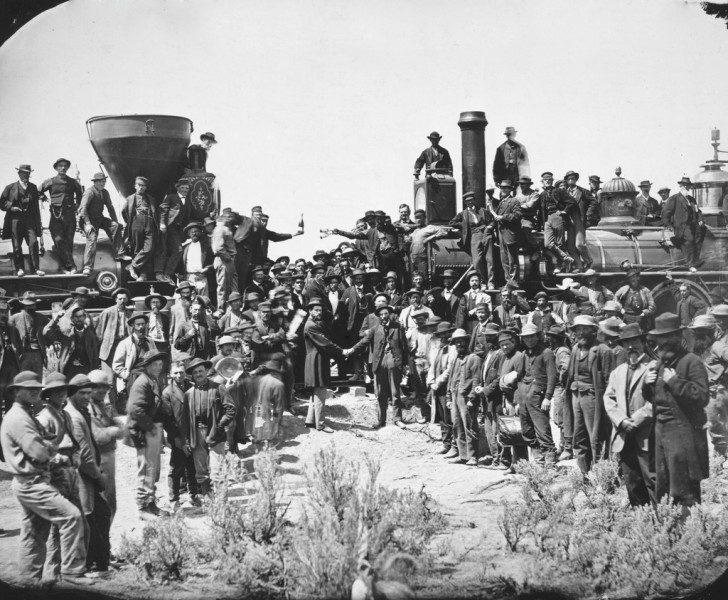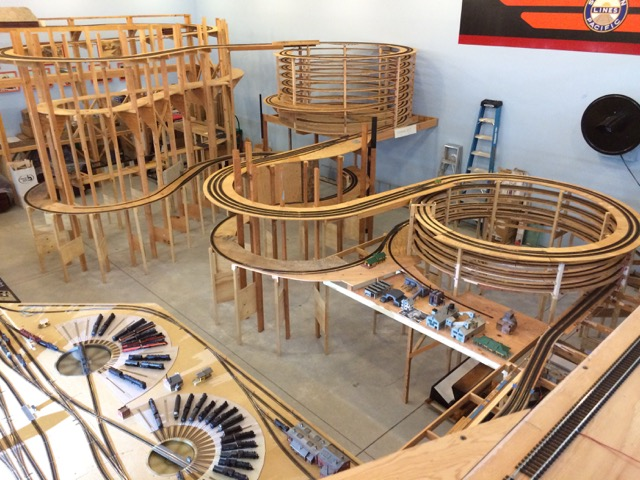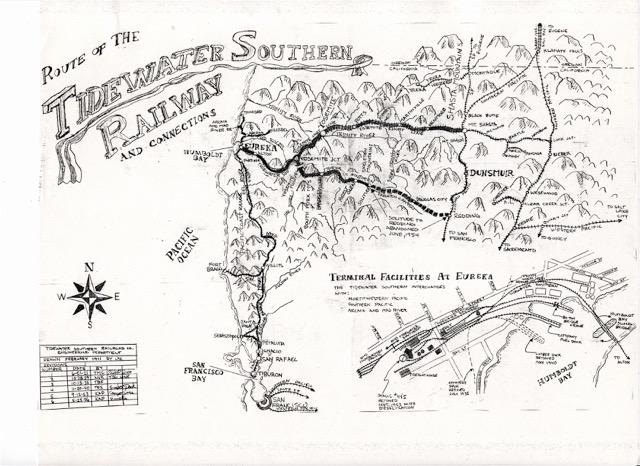The next installment in our ongoing series on planning and building a model railroad layout is all about layout themes. In case you missed our previous installment on track configurations, make sure to go back and check out that post for handy diagrams of common configurations. In this post, we’ll talk about establishing a theme that makes sense for your layout, using my own as an example.
But before we get started, let me first say that if you need inspiration for your layout project, read Nothing Like It in the World, by Stephen E. Ambrose. The story of the building of our first transcontinental railroad is an unbelievably captivating account of the project from start to finish. If you have trains in your veins, reading this book will fill you with inspiration. Prepare your golden spike!

The historic Golden Spike moment
Now then, back to building our own empires. There are some things to consider regarding the space available, the curve radii, and possible helixes needed to accomplish your goals but we can discuss the details a bit later.

HO layout under construction with multiple helixes. Photo credit: Doug Hodgdon
More is better, right? But, take note: big steam, passenger trains, and modern cars running about 80 scale feet or more in length need wider curves and clearances than other shorter choices. Double-headers and long trains are cool, but as much as I would like to operate a big-time main line railroad in my space, it just isn’t possible. So in my case, I instead focused on what I could build.
My old HO basement layout featured a railroad in Northern California’s Redwood country I named “Tidewater Southern.” In a 20’ by 20’ area, I had plenty of room to model this fictitious short line.

Map of Doug’s “Tidewater Southern Railroad.” Photo credit: Doug Hodgdon
Then when I sold all of my HO models and switched full time to S-scale (1/64th), I decided to convert the back wall of my garage for my next venture. My new space wouldn’t allow a reasonable dog-bone curve for continuous running, so I designed a 2’ by 18’ shelf-type point-to-point industrial switching layout. My theme is to get the most enjoyment I can out of 36 square feet.
If you have a warehouse space and lots of time and money, I say go for it, but most of us live with restrictions on our rights-of-way, so compromise is in order. A layout doesn’t have to be big to be great. I’ve seen some really fantastic small layouts. There can be great fun and talent in putting more in less.
My layout is a semi-fictitious stub-end standard gauge branch line off my favorite railroad, the Southern Pacific in California. Other choices are old time, short lines, narrow gauge, specialty industrial railroads, or trolley lines.

Doug’s new switching layout featuring the Southern Pacific. Photo credit: Doug Hodgdon
I grew up in a town that had a 2’ gauge railroad serving a creosote plant, and I have a collection of Southern Pacific narrow gauge equipment, but after considering the options, my SP standard gauge won out for layout construction.
I’d be very interested in your thoughts on layout design or space challenges you’ve overcome. Your comments are welcome.
More in this series:
So You Want to Build a Model Railroad Layout?
Choosing Model Railroad Track Configurations
Assigning a Theme for Your Model Railroad Layout
Ideas for Unique Layout Concepts
Tips on Trackwork
Helpful Tips for Model Railroad Wiring
Creative Ideas for Model Railroad Structures

Love the multiple helixes. I have two layouts, large HO 24x24, and N 14x19. Both are prototypical devoted to the transition SP Coast Line. The N is a replica of the Ventura Sub, has 4 decks, 4 helixes. I can duplicate a 1956 schedule in 6:1 time, traveling the mainline from LA Taylor yard(LA) to La Conchita(Santa Barbara) duplicating real time! The design is amazing for capturing complex action. The HO is prototypical Cuesta Grade with accuracy in 4:1 time from SLO to Santa Margarita.
I too have been "collecting" for several years. I have a dedicated space (9'x12') for a layout, but the design is very much all over the place. I've settled on Kato name trains, and have several. ignoring the repainted F7s in favor of BLI Alco PA/B/A set for the California Zephyr, And a BLI T1 for the PRR Broadway Limited. My Milwaukee Road Hiawatha & 20th Century Limited still await proper power. Kato Unitrack sets & pieces fill several crates, and my rolling stock is split between the club layout and home storage. but my 'theme' if there is one, is 'Glory Days'.
Built a 3 level railroad without a helix. Main line is 431 ft. 3 major rail yar
Did I miss something? I have re-read the "assigning a theme for your railroad" but no whre does it discuss a theme. Are we talking about themes such as shortline, logging, mining, mainline ops???? I'm very interested in what is involved in selecting a theme for a layout.
I am building "the Scania Pacific Railroad" which is a mix of Sweden and US. Half my train room is a mix of mostly New England and some Midwestern USA. The other half or so is a Swedish townscape and train land. The room is 23 x 20 feet with a big peninsula in the middle and a shelf type layout around the room. I am running Santa Fe, Pennsy and Milwaukee and the Swedish State Railway (SJ). Scania is the Latin name on the county in Sweden were I am living.
I started several layouts as a boy, but now that I'm retired, I'm getting back into trains. My favorite engines through all those years have been the NYC "Hudson" 4-6-4, and the PRR GG-1. Not having the space or money to model New York City and its environs, I needed to create a fictitious line that both would share. Since I would have to model a small town, the answer was a fictitious shared main line in the Pennsylvania - New York border area, with a short line that served the area, having an interchange into the shared mainline. For a short distance through town, the short line and the mainline share some track, with the main line going double track outside of town and the short line skirting the edge of town and serving the two industries, a canning company and a dairy. All this is being done in HO on a table that is 5 1/4 by 8. One major difference between my town and most of the railroads shown in magazines and internet is that I wanted places to live for my townspeople who work in the stores and factories, I have 11 houses and an apartment house crammed into this little town. Naturally, when the PRR passenger and the NYC freight are not running through town, they are "hiding out" on the double track mainline outside of town. If I can get an extra 4' by 4' piece on the end, I can create a vision barrier so those two trains can really hide out. I have two small sidings where the short line passenger and freight trains can rest between trips. The time is mid 1950's, allowing my short line to use steam and diesel. I have neither the skill nor the inclination to wire catenary for the GG-1, so that has to be supplied by the mind of the viewer. If any of you saw the stuff I put in my initial comments when I joined Model Railroader online, you know I'm talking about the Pennsylvania - New York Border railroad, nicknamed the Penny Line. I will be the sole operator (unless I can get my grandsons interested as they were when they were little), so operating sessions will probably last 10 - 20 minutes. Track work is primarily Bachmann EZ-Track, using blocks controlled by Atlas Selectors (can't afford DCC). Scenery, other than structures, is non-existent at this point. I guess that means that, in spite of using HO scale, they're really toy trains. I'd like to replace all this with N scale, which I think my eyes can handle, but my hands might be getting too shaky to do it; then there's the cost factor to replace the hundreds of dollars already invested.
Lighting use multi color LED string 5 meter long that are dimiable to highlight zones/area. Low red + low yellow + medium blue for sunrise Medium red + low yellow + low blue for sunset Medium yellow + high blue + medium white for Daylight Low red +high blue + low white for night put green + blue + yellow LED in buildings
Sixty-six and starting layout after fifty years of everything being boxed up. Steam in the eighteen hundreds is my passion
A theme. I suggest that, if possible, one visits as many other model railroads as possible. It took me many tries, and half finished railroads, before I discovered that I like small railroads, preferably narrow gauge, with meandering track, and well worn equipment. Sure arrow straight mainlines with 50 car trains are impressive, but that isn't want I like to watch, nor what I like to model. I could have saved a lot of time and money had I discovered this sooner. Instead I kept trying to replicate the class one model railroads I saw in magazines.
This is an interesting discussion. I settled on the turn of the century Morenci Southern Railway to model. A narrow gauge mining railroad running 14 miles up a mountain in Arizona. Supplies, and coal run up the mountain to mines, a large company store and a smelter at the top. Large copper ingots run down the mountain It was also a tourist railroad in those days. A hand full of engines and cars. Standard gauge on one end, and what is called "baby" gauge up on the mountain with a spider web of tracks with little Porters and mine cars. The Morenci Southern was nicknamed "The Corkscrew to America." There was a series of trestles creating loops across a ravine that allowed the railroad to climb up the mountain. The loops are what makes the railroad unique. Unfortunately my space to have my model railroad in is unusual in its floor design. I just couldn't find a way to include the loops in the space I had. I am still working in the same copper mining theme in narrow gauge. The current layout is a mountain climbing layout with the loops. I might still use the Morenci Southern Railway name. My favorite themed narrow gauge model railroad is David Meek's Thunder Mesa Mining Company.